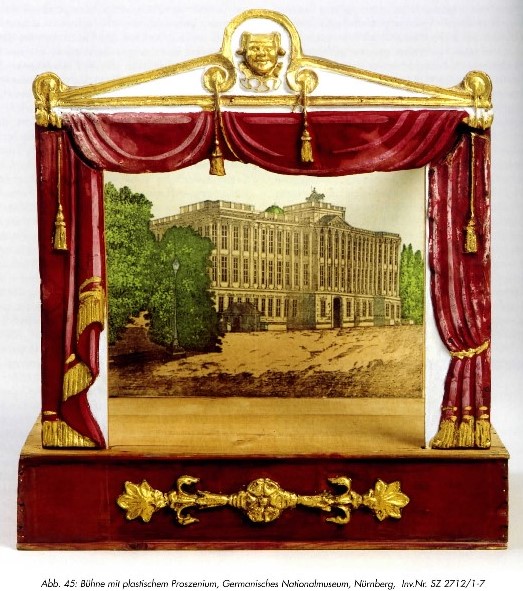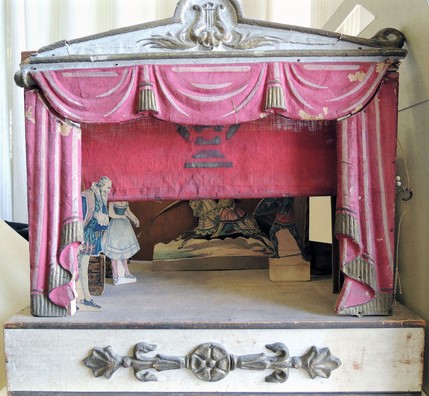With enormous thanks to Alain Lecucq, actor, director, and paper theater historian writing from France, our two paper theaters have been identified: the prosceniums made in Vienna, Austria, at the beginning of the 20th century.
Theatre one in: Anna Feja Seitler and Heino Seitler, Papiertheater: die Sammlung Anna Feja Seitler und Heino Seitler, edited by Norbert Donhofer (Wien : F. Deuticke, 1992). Access: http://catalogue.bnf.fr/ark:/12148/cb356821235

Theatre two in: Katharina Siefert and Ingrid Wambsganz, Papiertheater: Die Bühne im Salon: Einblicke in den Sammlungsbestand des Germanischen Nationalmuseums: Begleitpublikation zur Ausstellung “Theaterdonner” im Germanischen Nationalmuseum, 19.12.2002-23.3.2003 (Nürnberg: Verl. des Germanischen Nationalmuseums, 2002). Access: http://swbplus.bsz-bw.de/bsz102833435inh.htm
See also:
Alain Lecucq, Le Théâtre de papier: des origines à nos jours (Epinal: Centre départemental de documentation pédagogique des Vosges, 1984).
UNIMA 2000: l’art mondial de la marionnette = The Worldwide Art of Puppetry, edited by Marek Waszkiel; Penny Francis; and Alain Lecucq ([Prague]: Union internationale de la marionnette, 2000).
Petite histoire du Théâtre de papier… Cette technique de manipulation de figurines plates dans une scénographie miniature naît, vrais emblablement, au début du XIX e siècle en Angleterre. C’est en 1811, qu’I.K.Green publie, à Londres, la première façade de théâtre à monter. Ces théâtres vont se composer de plusieurs éléments indispensables pour jouer un spectacle : une façade, souvent inspirée de théâtres existants, des décors et des coulisses, des personnages dans des positions variées et un texte, résumé souvent malhabile de celui d’origine. Ces feuilles seront mises en couleurs par l’imprimeur avec des techniques diérentes selon les pays – peinture à la main, au pochoir, lithographie…ou par l’acheteur lui-même. A la maison, l’heureux possesseur de ces feuilles les collera sur du carton puis les découpera, les assemblera, et présentera son spectacle à sa famille ou à ses amis.La taille de ces théâtres dépassera rarement les cinquante ou soixante centimètres. Outre l’Angleterre, on trouve des théâtres de papier en Autriche, en Allemagne, au Danemark, en Espagne, en Italie, en Moravie et en France
A little history of the Paper Theater … This technique of handling flat figurines in a miniature scenography was born, most probably, at the beginning of the 19th century in England. It was in 1811 that I. K. Green published the first theater facade to be erected in London. These theaters will consist of several elements essential to play a show: a facade, often inspired by existing theaters, sets and backstage, characters in various positions and a text, often clumsy summary of the original one. These sheets will be colored by the printer with different techniques depending on the country–hand painting, stenciling, lithography–or by the buyer himself. At home, the happy owner of these sheets will stick them on cardboard and then cut them, assemble them, and present his show to his family or friends. The size of these theaters will rarely exceed fifty or sixty centimeters. Besides England, there are paper theaters in Austria, Germany, Denmark, Spain, Italy, Moravia and France

